Written and Photographed by Koa Kalish
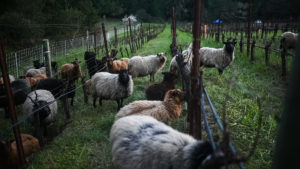
Ted Lemon has worked in viticulture his entire adult life, since 1981.
After graduating college with a liberal arts degree, he lived in France for 4 years. In Burgundy, he fell in love with the wine world, working in the vineyards there. Eventually, he moved to Napa Valley to see what the wine world was like in California. After 7 years working in Napa, he met his wife Heidi and they started Littorai Wines in 1992.
The word Littorai derives from the Latin root littor and the Greek plural ai, and means “the coasts”. Ted and Heidi searched for the finest areas along the coasts to grow Chardonnay and Pinot Noir — two Burgundian varieties that Ted had worked intimately with in France. In 2000, they purchased their first vineyard land near Occidental. At that time, Ted had farmed conventionally for 20 years. Tired of the conventional way of farming, he sought to do something different. The question was, how?
“After 20 years of conventional farming, I no longer believed that western agronomic theory could truly explain why and how plants grow and reproduce,” Ted says. In order to farm alternatively, Ted saw two options: organic or biodynamic.
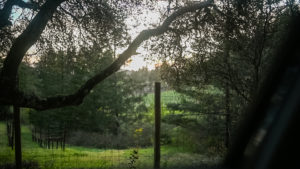
Ted chose biodynamic, because the paradigm was radically different from western agronomic theory. “Although there are many lovely organic farmers out there, it is possible to farm organically but still adhere to western agronomic theory,” Ted explains. Since he no longer believed in that theory, biodynamic farming would be truly a change, and a challenge.
In Ted’s words, biodynamic farming “holds the foundation of a world enlivened by spirit — that all material is manifestation of a spiritual reality. In biodynamic farming, we work with the energies and powers of the spiritual world as it manifests in the material world. We work with celestial rhythms and specific preparations to strengthen the plants and animals.”
He cites the following example from ecology, “Mature forests have reached the point of dynamic equilibrium — in other words, they are able to remain essentially unchanged for thousands of years. I ask, ‘What does the forest know that I don’t know?’” Ted wanted to find a model of farming that could achieve the balance and harmony of the forest.
This question opened the door to a much wider consideration of what farming is and what a healthy form of farming could be. “One of the main tenets of biodynamic farming is that the farm should be a self-sustaining organism,” he says. “This is an ideal, but to get there you have to have animals. Animals play a fundamental role in rejuvenating the soil.” This led the team at Littorai to gradually add different elements of diversity — animals in the form of cows, sheep, chickens, ducks, and even a donkey. Companion plantings and composting were also added, as essential elements of that diversity.

Why sheep? At Littorai, there is more acreage of pasture on the property than there is vineyard. The sheep are able to graze around 28 acres, grazing year-round through a rotational grazing program. In late summer and early autumn the sheep are rotated through the forest, helping in fire prevention.
The role of the sheep is to maintain and improve the health of open pasture and the vineyards, as they contribute to species diversity and fertilize the vineyard. The sheep increase organic matter and humus in the soil, sequester carbon, and ultimately, make the wine better. “Our vineyard should be seen as an integrated complex farm,” Ted says. “It is a ‘wine farm’ not a ‘vineyard monoculture.’”
“Viticulture is a very curious form of agriculture, as it evolved towards monoculture before most other forms,” Ted explains. “In much of Europe, viticulture was originally placed in the poor soils where vegetables wouldn’t grow well. There was a great diversity advantage to putting vines in poor areas.”
These places were on hillsides outside of towns. “The vineyard-winery model of agriculture is virtually unique in taking agricultural produce to a very sophisticated end product, all within one house. Alcoholic fermentation is a very complex chemical pathway. So not only are you transforming the original product, you’re bottling, ensuring stability and then selling into a marketplace that is quite complex,” Ted explains. “Vineyards and orchards are perennial crops. Hence, the way we think about soil fertility has to be dramatically different than for annual crops. The ruminants and their relationship to the permanent cover crop in the vineyard floor are critical, because of their long-term effects on those companion species,” he says.
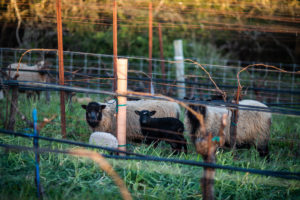
After adding sheep to the vineyard, Ted notices new things all the time, including an increase of species diversity in the grasses. “Without animals grazing, what I’ve seen over the years is that certain grass, forb, or legume species tend to dominate. Thus, species diversity becomes limited, resulting in poor soil health. The presence of the grazers naturally increases that.”
“This can be expressed simply in the formula, the wisdom of the animals — that the animals give back to the soil exactly what that soil needs. There is an extraordinary alchemy between what they consume and what they defecate. And, it isn’t just their digestive ruminant tracks, it is also the way that they eat.”
Different ruminants eat in different ways. For example, sheep mouths are very different from cows’. Because they are nibblers, sheep are very precise with what they eat. Through decisions like these, a person or a farm can influence the diversity of the species in the cover crop mix. Even within a single vineyard, depending on the section that they are grazing, Ted and his team may have them grazing the grasses to different degrees. It takes a lot of learning, and a close relationship with the animals. “It goes without saying that a mower can do none of the above,” says Ted with a laugh.
Even between different species of sheep, there are radical differences in how and what they will eat. It took Ted and his team quite a while to hone in on what sheep would be bioregionally appropriate and best fit for the task. They settled on Shetland (of which they now have 40, increasing by the day with spring lambs). “Shetlands are hearty and independent. They need virtually no assistance with births. They are not fussy eaters. They graze a bit like goats, eating briars and brambles.”
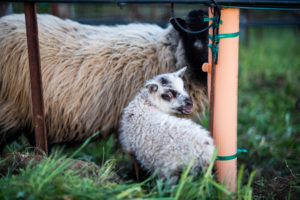
At Littorai, the relationship between the humans and the animals is very important.
“Wine people are not usually animal people,” Ted says. “We had to learn and adapt to a very different paradigm. Wine has its rhythm and so does the plant world. These can be partially altered by human choice, but with animals, it’s not like that.” For Ted and his team, this has certainly been a time consuming and very rewarding change.
“When you work with animals which are not pets, you learn a whole new respect for the natural world because of the very different relationship they have with it. You have to work with their natural rhythms, and it connects you to the natural world in a new way.” Ted can’t hire traditional wine people anymore because they have to be willing to work with animals, and they must have a passion for the animals. “It’s been remarkably easy to find those people,” he says. “There’s a shift going on right now. That would not have been the case 25 years ago.”
Luckily, the world seems more ready than ever for a shift towards holistic agriculture, and Littorai is leading by example.
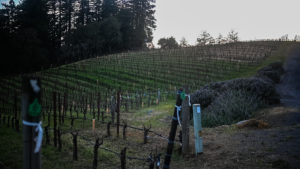
—
Ted Lemon is the founder and manager of Littorai, overseeing 10 full-time employees in production, including associate winemaker Sam Ecenia, cellar master Chris Casale, and vineyard manager Pedro Viramontes. The four men collaboratively manage the animals, 40+ sheep, 6 cows, one donkey, two guardian dogs, ducks, and chickens. Go visit their wine farm to meet the animals, and see more at littorai.com.
